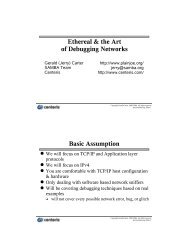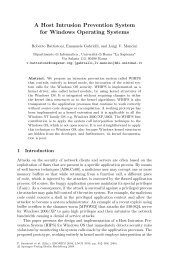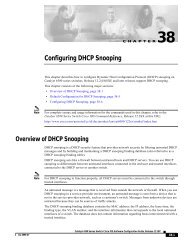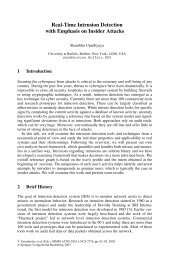Advanced Windows 2000 Rootkit Detection (Execution Path Analysis)
Advanced Windows 2000 Rootkit Detection (Execution Path Analysis)
Advanced Windows 2000 Rootkit Detection (Execution Path Analysis)
You also want an ePaper? Increase the reach of your titles
YUMPU automatically turns print PDFs into web optimized ePapers that Google loves.
inc counter;<br />
iret;<br />
NewKiSystemService:<br />
if (current_pid == trace_pid)<br />
setTFbit();<br />
jmp KiSystemService;<br />
IDT<br />
...<br />
0h<br />
1h (#DB)<br />
2h<br />
2Eh (Win<strong>2000</strong>)<br />
KiSystemService:<br />
...<br />
call [ebx]; // call System Service<br />
...<br />
iret;<br />
...<br />
FFh<br />
Figure 2. Simplified diagram of what is hooked by instruction counter.<br />
Implementation of instruction counter<br />
To implement instruction counting, we can use a nice feature of Intel processors, the so<br />
called single stepping mode. When the processor is working in this mode, it will generate<br />
debug exception (#DB) after every instruction which was executed. To put processor into<br />
this mode, we have to set TF bit in the EFLAGS register (see [6] for details).<br />
Processor clears TF bit when executing int instruction and this instruction is causing<br />
privilege change. It means that if we want to count the instructions executed in kernel<br />
mode, we have to set TF bit at the beginning of interrupt handler. Because we would like<br />
to measure the number of instructions executed during some system services, it is<br />
convenient to hook interrupt vector 0x2e, which is <strong>Windows</strong> <strong>2000</strong> system service gate.<br />
However, because some rootkits are user-mode based (see [4]), we should also be able to<br />
count the instructions executed in ring3 before, and after, kernel service. This is simple,<br />
we just have to set TF bit in user mode and we do not have to bother to set it again after<br />
return form kernel-mode, because processor will restore this bit automatically.<br />
The counting mechanism has been implemented as a kernel driver. After loading, it<br />
hooks IDT 0x1 and 0x2e entries as showed on figure 2. Of course the module must<br />
communicate with userland to allow testing process getting the results. In current<br />
implementation kernel driver hooks one system call which will be used as a interface to<br />
the driver. User mode process can then start and stop the counting process by calling this<br />
specific system call.<br />
4









